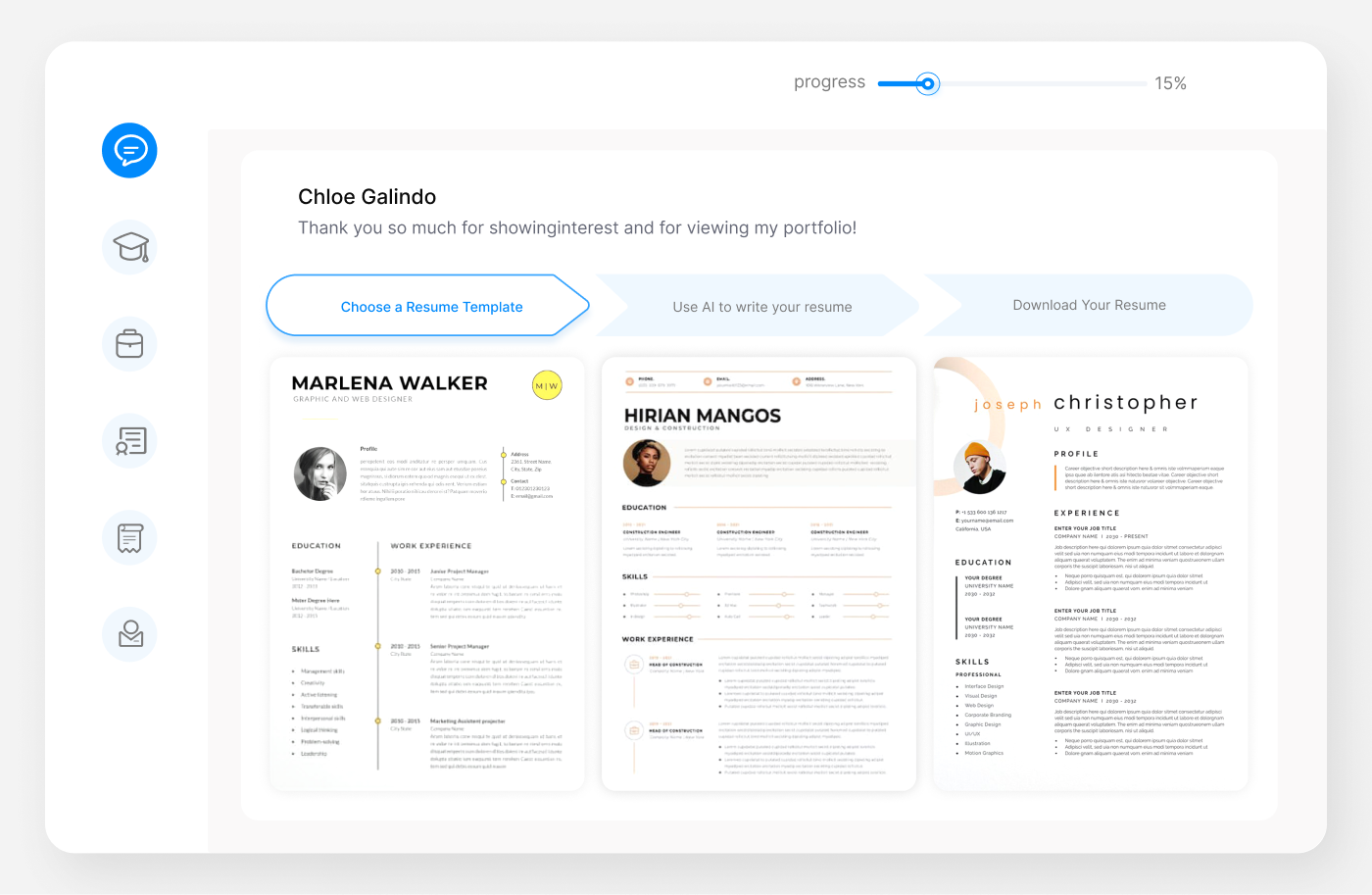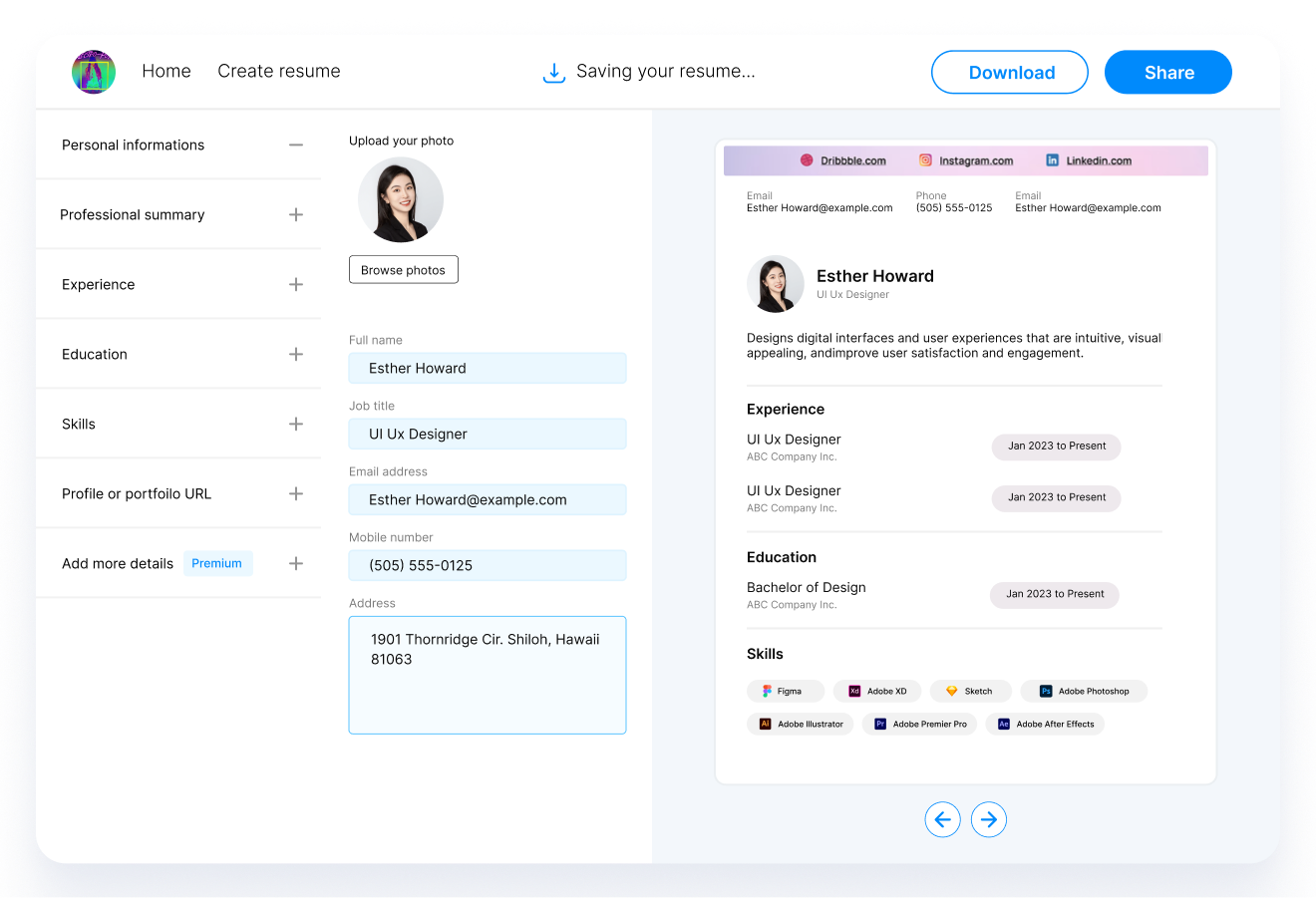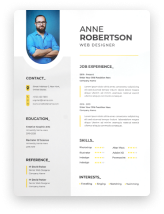In today's fast-paced business world, standing out as a leadership candidate requires not just exemplary skills and experience, but also a resume that effectively communicates your strengths and vision. Whether you're aspiring to C-suite positions or aiming to lead a department, your resume is your first introduction to potential employers. It's not just a list of your past roles; it's your personal marketing document, your professional biography that tells the story of your career journey, your leadership style, and your accomplishments. Crafting a resume that captures the essence of your professional persona while aligning with the expectations of the business leadership role you're aiming for is crucial. This guide is dedicated to helping you navigate the complexities of resume writing tailored to business leadership roles, ensuring that your application not only stands out but also resonates with the ethos of modern business excellence.

A Standout Business Leader Resume Example
Diana Markus
San Francisco, CA | 415-555-0198
d.markus@execmail.com
LinkedIn: linkedin.com/in/dianamarkus
Twitter: @DianaLead
EXECUTIVE SUMMARY
Dynamic and visionary business leader with over 15 years of experience steering companies through periods of accelerated growth. Skilled in strategic planning, market expansion, and team development. Proven track record of enhancing operational efficiency and boosting financial performance. Recognized for exceptional leadership in managing projects valued at over $100 million and leading cross-functional teams of 100+ members.
PROFESSIONAL EXPERIENCE
Chief Operating Officer
Tech Innovate Solutions, San Francisco, CA
January 2018 – Present
- Spearheaded the operational strategy that resulted in a 40% increase in operational efficiency and a 30% reduction in costs.
- Led the expansion into 3 new international markets, resulting in a 50% increase in global revenue.
- Implemented a new agile project management system, increasing project completion rates by 25%.
Vice President of Operations
Global Tech Enterprises, San Francisco, CA
June 2010 – December 2017
- Directed a team of 200+ in the development and execution of operational strategies, achieving a 95% employee satisfaction rate.
- Managed a portfolio of projects worth $80 million, delivering a 20% return on investment.
- Introduced cutting-edge technologies that elevated the company's market position and led to a 35% growth in market share.
Director of Business Development
Innovative Solutions Inc., Palo Alto, CA
March 2005 – May 2010
- Formulated and executed a strategic plan that doubled the company size within five years.
- Cultivated partnerships with key industry players, leading to a 200% increase in strategic alliances.
- Enhanced the sales process with data-driven approaches, resulting in a 70% increase in sales revenue.
EDUCATION
MBA, Strategy and Management
Stanford University, Stanford, CA
Graduated: June 2004
B.S. in Business Administration
University of California, Berkeley, CA
Graduated: May 2002
SKILLS
- Strategic Planning & Implementation
- Market Expansion & Growth Strategies
- Financial Management & Cost Reduction
- Leadership & Team Development
- Operational Efficiency & Agile Methodologies
CERTIFICATIONS
- Certified Project Management Professional (PMP)
- Project Management Institute
- Certified ScrumMaster (CSM)
- Scrum Alliance
AWARDS
- Business Leader of the Year
- National Business Association, 2019
- Top 30 Under 30 in Business, Forbes, 2003
Crafting a resume that stands out in the competitive landscape of business leadership is both an art and a science. Your resume is more than a mere chronicle of your work history; it's a strategic tool designed to showcase your most relevant experiences, skills, and accomplishments in a way that resonates with potential employers. Here’s how to structure your resume to make a powerful impact:
The Foundation: Clear Formatting and Organization
Start with a clean, professional layout that makes it easy for recruiters to scan. Use a standard font like Arial or Calibri, set to a size between 10 and 12 points, and ensure your margins are evenly set to create a balanced look. A well-organized structure includes clear headings, bullet points for detailing experiences and achievements, and a logical flow of information.
Prioritize the Top Third
The top third of your resume is prime real estate. It’s what hiring managers see first when they glance at your application, so make it count. Begin with a compelling executive summary that highlights your leadership philosophy, key achievements, and the value you bring to a business leadership role.
Experience Section: More Than Just Job Titles
Under each position, don't just list your job duties. Focus on your accomplishments, quantifying them with metrics whenever possible. Did you lead a team to exceed sales targets? By how much? Did your strategies increase operational efficiency? Provide percentages to demonstrate the impact of your work.
Tailoring Your Resume
Customize your resume for the role you're applying for. This doesn't mean rewriting your resume from scratch each time, but it does mean adjusting the emphasis of your experiences and achievements to align with the job description. Use keywords from the job listing to get past applicant tracking systems (ATS) and catch the eye of the hiring manager.
Keep It Relevant and Concise
While it’s tempting to list every achievement in your illustrious career, focus on the most relevant experiences. Keep your resume to a maximum of two pages to ensure it's digestible at a glance. Older positions can be summarized or omitted if they don’t add value to your current job application.
Final Polish
Proofread your resume meticulously to avoid typos and grammatical errors, which can be a red flag for potential employers. Consider professional feedback or using resume-review tools to refine your document further.
Crafting an Engaging Resume Summary or Objective: Your First Impression
The resume summary or objective is your chance to make a powerful first impression. It's a brief statement at the top of your resume that introduces you, highlights your professional achievements, and outlines what you aim to bring to a potential employer. Here's how to make it compelling:
The Art of the Summary
For experienced business leaders, a resume summary is the way to go. It should succinctly encapsulate your years of experience, key achievements, and the value you bring to the table. Focus on what sets you apart: Have you driven company-wide transformations? Led mergers or acquisitions? Spearheaded market expansions? Quantify these achievements to give them weight.
Crafting a Persuasive Objective
If you're transitioning into a leadership role or your experience isn't extensive in the business sector, an objective might be more appropriate. Here, the focus shifts slightly towards your career goals and how they align with the company's objectives. It's an opportunity to showcase your ambition, drive, and how your unique skills can address the company's needs.
Tailoring Is Key
Whether you opt for a summary or an objective, customization is crucial. Align your statement with the job description, using keywords and phrases from the posting to make it relevant and ATS-friendly. This customization shows you're not just casting a wide net but are genuinely interested in this particular role.
Examples That Stand Out
Summary Example:
Dynamic Business Leader with over 15 years of proven success in strategic planning, market expansion, and team leadership. Spearheaded the turnaround of a struggling business unit, resulting in a 50% increase in profitability within two years. Seeking to leverage extensive experience to drive sustainable growth and excellence at XYZ Corporation.
Objective Example:
Aspiring Business Leader with a strong background in project management and strategic planning, looking to leverage skills in a dynamic leadership role at XYZ Corporation. Eager to contribute to strategic initiatives and drive positive change, drawing on a successful track record of delivering projects on time and within budget.
Final Thoughts
Remember, your summary or objective is not just a statement; it's your elevator pitch. It should be compelling enough to encourage the hiring manager to read on, showcasing your potential to add value as a business leader. Keep it concise, make it impactful, and always tailor it to the role at hand.
Crafting the Perfect Work Experience Section for Business Leaders
The work experience section is arguably the most critical part of your resume, providing a detailed look at your career progression and accomplishments. Here's how to construct this section to showcase your leadership capabilities and achievements:
Focus on Impact and Leadership
Rather than listing tasks you've managed, concentrate on the impact of your work. Highlight leadership experiences where you've made significant contributions, led teams, or driven projects that had a measurable impact on the organization. Use action verbs to start each bullet point, making your roles and achievements stand out more dynamically.
Quantify Achievements
Whenever possible, quantify your achievements with numbers, percentages, or financial figures. This provides concrete evidence of your success and the value you've brought to previous positions. For instance, "Increased departmental revenue by 30% through strategic business development initiatives" is more impactful than "Responsible for business development."
Tailor Your Experience
Adapt your work experience section to the job you're applying for by emphasizing the most relevant experiences. This might mean not every role you've had is included, especially if it's not directly related to the leadership position you're seeking.
Highlight Leadership Skills
Include examples of your leadership skills in action, such as managing teams, leading projects, or implementing strategic initiatives. This can also include times you've mentored or coached others, led training sessions, or spearheaded change within an organization.
Examples of Strong Work Experience Entries
Strategic Business Leader
TechCorp Innovations
San Francisco, CA | April 2015 - Present
- Orchestrated a strategic turnaround, increasing company profitability by 40% within two years.
- Led cross-functional teams of over 100 employees in the development and launch of a new SaaS product that captured 20% market share in its first year.
- Negotiated partnerships with key industry players, resulting in a 25% increase in annual revenue.
Director of Operations
Global FinTech Solutions
New York, NY | Jan 2010 - Mar 2015
- Managed a portfolio of projects valued at over $50 million, delivering a 35% return on investment.
- Implemented agile project management techniques, reducing project delivery times by 20%.
- Spearheaded the adoption of AI and machine learning technologies, enhancing operational efficiency and reducing costs by 15%.
Pro Tips for Your Work Experience Section
- Use Reverse Chronological Order: Start with your most recent position and work backward. This format highlights your career progression and recent achievements.
- Be Specific: Vague descriptions won't do you any favors. Be specific about what you did, how you did it, and the outcome.
- Tailor Your Language: Use language that mirrors the job description, including keywords and industry terms. This makes it easier for ATS systems and hiring managers to see your relevance.
Highlighting Your Educational Achievements: Building Credibility and Expertise
For business leaders, education is not just about the degrees earned; it's a testament to your foundation in critical thinking, strategic planning, and leadership. Here's how to effectively showcase your education on your resume to complement your professional experience:
Positioning Your Education Section
Typically, the Education section comes after your Work Experience, especially if you have several years of job experience. However, if you're a recent graduate with less experience, you might place Education before Work Experience to highlight your academic achievements.
Listing Degrees and Institutions
Start with your highest degree, followed by any other degrees in reverse chronological order. Include the degree type, your major, the name of the institution, and the graduation year. If you graduated with honors or a high GPA, and you believe it's relevant, include that as well.
Advanced Degrees and Executive Education
For business leaders, advanced degrees (like an MBA) or specialized executive education courses can be particularly compelling. They signal a commitment to continuous learning and expertise in areas critical to leadership and business strategy. List any relevant advanced degrees or executive programs, focusing on those that are most applicable to the leadership role you're applying for.
Including Relevant Coursework and Projects
If you're transitioning into a leadership role from a different field, or if you have taken courses directly relevant to the job you're applying for, you might choose to include selected coursework or projects. This can help to demonstrate your knowledge and skills in specific areas, even if your work experience is in a different domain.
Certifications and Continuous Learning
In addition to formal education, certifications in project management, leadership, finance, or industry-specific areas can bolster your resume. They demonstrate a commitment to enhancing your skills and staying current in your field. List any relevant certifications, including the issuing organization and the date of certification.
Examples of Education Section Entries
MBA, Strategy and Leadership
Stanford Graduate School of Business, 2018
- Graduated with honors, GPA: 3.8/4.0
Bachelor of Science in Business Administration
University of California, Berkeley, 2014
- Concentration in Finance, Minor in Economics
Certifications:
- Certified Project Management Professional (PMP)
– Project Management Institute, 2020 - Certified Financial Planner (CFP)
- CFP Board, 2019
The Role of Education in Your Leadership Profile
Your education section should complement your professional experience, highlighting your foundation in leadership, strategic thinking, and other key areas relevant to the role. While it's important to be concise, providing a clear and comprehensive view of your educational background helps to build your credibility and showcase your preparedness for leadership challenges.
Illuminating Your Skills: Tailoring Your Expertise for a Business Leader Role
The Skills section of your resume is your opportunity to succinctly showcase the capabilities that qualify you for a leadership position. In a business leader role, certain skills are particularly valuable, including strategic planning, leadership, financial acumen, and innovation. Here’s how to effectively highlight these and other relevant skills:
Strategic Skill Selection
Choose skills that are most relevant to the role you're applying for, based on the job description and your knowledge of the industry. While technical skills relevant to your field are important, don't overlook soft skills such as leadership, communication, and problem-solving, which are crucial for a business leader.
Balance Between Hard and Soft Skills
- Hard Skills: These might include financial analysis, market research, operations management, or proficiency in specific software. These skills are often acquired through education, training, and experience.
- Soft Skills: Essential for leadership roles, soft skills like strategic leadership, team building, negotiation, and adaptability are harder to quantify but critical for success.
Quantifying Skills When Possible
Whenever you can, provide context or examples that demonstrate your proficiency in a skill. For instance, instead of merely listing "team leadership," you could say, "Led a cross-functional team of 50+ members, driving a 30% increase in productivity."
Prioritize According to Relevance
Order your skills with the most relevant and important ones listed first. This ensures that hiring managers see your most applicable skills at a glance.
Keep It Concise
While it might be tempting to list every skill you possess, focus on a curated selection of skills that are most relevant to the leadership role you're seeking. A concise, targeted list is more impactful than a lengthy catalog of abilities.
Examples of Skills for a Business Leader Resume
- Strategic Planning & Execution
- Financial Forecasting & Budgeting
- Cross-Functional Team Leadership
- Market Expansion Strategies
- Change Management
- Data-Driven Decision Making
- Innovation & Growth Initiatives
- Stakeholder Engagement & Communication
- Crisis Management
- Operational Efficiency
Reflecting on Skill Development
Consider the skills section as a reflection of your ongoing professional development. Highlighting skills that are both current and relevant to the challenges of a business leader role demonstrates your readiness to lead and adapt in a rapidly changing business environment.
Enriching Your Resume with Additional Sections: Elevating Your Business Leader Profile
To distinguish yourself in a pool of business leader candidates, consider adding sections to your resume that go beyond the standard fare. These additional sections can showcase your broader competencies, achievements, and personal initiatives, providing a fuller picture of your leadership qualities and professional ethos.
Certifications and Licenses
Relevant certifications can add significant value to your resume, especially those recognized within your industry or profession. They demonstrate a commitment to your development and mastery in specific areas. For example, a Project Management Professional (PMP) certification can be a powerful endorsement of your project management skills.
Awards and Honors
Highlight any awards or honors you've received that are relevant to the role or industry. These recognitions serve as external validations of your skills and achievements. Be specific about what the award was for and the scope of the competition, if applicable.
Professional Affiliations
Membership in professional organizations not only shows your commitment to staying connected with industry trends and peers but can also indicate leadership roles outside of your employment, particularly if you've held any positions within these organizations.
Publications and Presentations
If you've contributed to professional journals, blogs, or have been invited to speak at industry conferences, listing these accomplishments can highlight your expertise and thought leadership. Be sure to include the titles, publication dates, or event names.
Volunteer Work
Volunteer positions, particularly those that demonstrate leadership or a commitment to causes relevant to the industry you're targeting, can be included. This shows a rounded character, your ability to work with diverse teams, and a commitment to giving back.
Personal Projects or Ventures
If you've initiated any projects or ventures that are relevant to your professional interests or demonstrate entrepreneurial spirit, include these as well. They can be particularly telling about your initiative, creativity, and ability to lead and manage projects.
Languages
Fluency in additional languages can be a significant asset in global roles or organizations with a diverse workforce. List languages in which you are proficient, especially those relevant to the markets the company operates in.
Examples of Additional Sections for a Business Leader Resume
Certifications:
- Certified ScrumMaster (CSM)
- Six Sigma Black Belt Certification
Professional Affiliations:
- Board Member, Local Business Chamber
- Member, National Association of Sales Professionals
Publications:
- “Innovating Future Markets,” Industry Today Journal, May 2021
- Keynote Speaker, Annual Leadership Summit, 2022
Volunteer Work:
- Mentor, Young Entrepreneurs Program
- Volunteer Coordinator, Community Food Bank
Crafting the Perfect Cover Letter for Your Business Leader Application
A cover letter is your opportunity to speak directly to the hiring manager, providing a narrative to your resume and highlighting why you are the ideal candidate for the leadership position. While your resume showcases your accomplishments and skills, your cover letter should weave these into a compelling story that aligns with the company's goals and culture. Here’s how to craft a cover letter that makes a memorable impression:
Start with Research
Before you write your cover letter, research the company thoroughly. Understand its mission, values, and recent accomplishments. This knowledge will help you tailor your cover letter to demonstrate not just why you want the role, but why you want it at this particular company.
Address the Hiring Manager Directly
If possible, address your cover letter to the specific person responsible for hiring. This personal touch demonstrates your attention to detail and willingness to go the extra mile.
Opening Paragraph: Grab Their Attention
Begin with a strong opening that hooks the reader. Share briefly why you’re excited about the opportunity and how your values align with the company's mission. This sets a positive tone for the rest of the letter.
Body: Highlight Key Achievements and Skills
Use the body of your cover letter to expand on a few key achievements mentioned in your resume. Explain how these experiences have prepared you for the challenges of the role you're applying for. Be specific and use this opportunity to show how your leadership made a tangible difference.
Show How You Fit With the Company Culture
Employers look for leaders who can not only perform but also inspire their teams and fit in with the company culture. Share an example of how you’ve cultivated a positive team environment or led through change, demonstrating your leadership philosophy and how it aligns with the company’s culture.
Closing: Express Enthusiasm and Invite Further Discussion
In your closing paragraph, reiterate your enthusiasm for the role and the value you’d bring to the team. Politely invite the hiring manager to discuss your application in further detail, indicating your willingness for an interview.
Examples of Engaging Cover Letter Openings
- "I was thrilled to see the opening for the [Position] at [Company] not just because of my passion for leading high-performing teams, but also because of [Company]’s commitment to [something you admire about the company]."
- "When I led my team through a successful market expansion at [Previous Company], it reinforced my belief in the power of strategic leadership—something I see at the heart of [Company]."
Keep It Concise
Your cover letter should complement your resume, not repeat it. Aim for three to four concise paragraphs that persuade the hiring manager to give your resume a closer look.
Concluding Insights and Final Touches: Ensuring Your Resume and Application Shine
As we wrap up our comprehensive guide to crafting a standout resume and cover letter for a business leader role, let's reflect on the key takeaways and consider some final thoughts for polishing your application.
Emphasize Leadership and Vision
Throughout your resume and cover letter, the recurring theme should be your ability to lead and execute a vision. Whether through strategic growth initiatives, team development, or innovative projects, ensure these elements shine brightly.
Tailor Your Application
A bespoke application tailored to each role and company demonstrates your genuine interest and effort. Use the job description as your guide to highlight the most relevant experiences, skills, and achievements.
Quantify Your Impact
Whenever possible, quantify your accomplishments to provide a clear picture of your impact. Metrics and tangible outcomes lend credibility and allow hiring managers to gauge your potential contribution.
Reflect Your Adaptability
Business environments are ever-evolving, and your resume should reflect your ability to adapt and thrive amid change. Highlight examples of navigating shifts in strategy, market conditions, or team dynamics.
Professional Presentation
Ensure your resume and cover letter are immaculately presented, with no typos or grammatical errors. Consider the design and layout of your resume, opting for a professional and readable format that enhances readability.
Engage with Your Network
Don't underestimate the power of your professional network. Engaging with contacts within your desired industry or company can provide invaluable insights and even referrals that strengthen your application.
Continuous Learning
Express your commitment to professional growth and learning. Whether through formal education, certifications, or self-directed learning, showing a proactive approach to development can set you apart.
Final Review
Before submitting your application, review it thoroughly. Consider seeking feedback from mentors, colleagues, or professional resume writers to ensure it's polished and compelling.
Stay Positive and Persistent
The job search process, especially for leadership roles, can be competitive and lengthy. Stay positive, be persistent, and keep refining your approach based on feedback and experiences.
Key Takeaway
The journey to securing a business leader role is both challenging and rewarding. Your resume and cover letter are crucial tools in this journey, offering a snapshot of your professional narrative. By thoughtfully crafting these documents to highlight your leadership, vision, and impact, you position yourself as a compelling candidate ready to drive success in your next role.
Crafting a standout resume and cover letter is a significant step towards your next leadership opportunity. Remember, these documents are more than just a summary of your career—they're your personal marketing materials, designed to showcase your unique value proposition as a business leader. With careful attention to detail, a focus on results, and a tailor-made approach for each application, you're well on your way to capturing the attention of your next employer.

FAQs: Navigating the Nuances of Crafting a Business Leader Resume
When it comes to crafting a resume for a business leader role, several common questions emerge. These FAQs aim to address those queries, offering clarity and guidance to enhance your resume writing process.
Q1: How Long Should My Resume Be?
For business leaders, a two-page resume is generally acceptable, given the breadth of experience and achievements typically involved. However, the key is relevance and impact; ensure every piece of information presented strengthens your candidacy.
Q2: Should I Include an Interests Section?
While not essential, a brief interests section can add a personal touch and offer insight into your personality and leadership style. If included, ensure it's concise and professionally relevant.
Q3: How Do I Address Employment Gaps?
Be transparent about employment gaps, using your cover letter or an additional section on your resume to briefly explain. Focus on activities during the gap that contributed to your personal or professional growth.
Q4: Can I Use a Functional Resume Format?
While a chronological format is preferred for its clarity and straightforwardness, a functional format can be used if transitioning industries or if your skill set is more relevant than your chronological work history. However, be mindful that this format might not be as well-received by all hiring managers.
Q5: How Often Should I Update My Resume?
Regularly update your resume, even when not actively job searching. Keeping your document current ensures you're ready for unexpected opportunities and helps you track your professional achievements.
Q6: Is It Necessary to Customize My Resume for Each Application?
Yes, customization is crucial. Tailor your resume to highlight the experiences and skills most relevant to each specific role and company, using keywords from the job description to pass through Applicant Tracking Systems.
Q6: How Important Are Keywords in My Resume?
Extremely important. Keywords from the job description help your resume get past ATS filters and draw the hiring manager's attention to your relevant qualifications. Include both hard skills and soft skills keywords.
Q7: What's the Best Way to Showcase My Leadership Skills?
Focus on achievements that demonstrate your leadership impact, such as team development, strategic initiatives you've led, or significant organizational changes you've implemented. Use action verbs and quantify your results.
Q8: Should I Include Social Media Profiles?
Include professional social media profiles, like LinkedIn, if they add value to your candidacy. Ensure your profile is updated and aligns with the professional image presented on your resume.
Q9: How Can I Make My Resume Stand Out?
In addition to tailoring and quantifying your achievements, consider adding a unique value proposition or a brief branding statement at the beginning of your resume to capture the essence of your professional identity and leadership style.
By addressing these common concerns and implementing the advice provided, you can craft a more effective and impactful resume that showcases your readiness and suitability for a business leader role.
Recommended Reading






